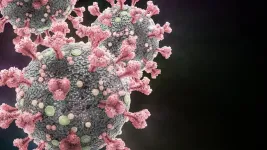New understanding of the deleterious immune response in rheumatoid arthritis
2021-04-16
(Press-News.org) Researchers within the Biomedicine Discovery Institute at Monash University have made a breakthrough in understanding the role played by high-risk immune genes associated with the development of rheumatoid arthritis (RA).
The findings, published in Science Immunology, were the result of a seven-year collaboration led by Monash University, involving Janssen Research and Development, USA and the Karolinska Institute, Sweden.
Certain immune system genes, called Human Leukocyte antigen (HLA)-DR4, cause an increased susceptibility to RA. In this study, using mice genetically modified to express the human HLA-DR4 molecule, the team examined, at the molecular and cellular levels, how T cells recognise these HLA-DR4 molecules. The team also showed that highly similar T cell receptors, likely with similar recognition characteristics, are also present in "RA-susceptible" humans expressing these HLA molecules.
"This suggests that there may be an immune signature of RA development, providing a potential avenue for diagnostic development or a window of opportunity for therapeutic development," says Dr Hugh Reid, who co-led the study with Professor Jamie Rossjohn and Professor Nicole La Gruta at Monash University.
With the assistance of the Australian Synchrotron, the researchers were able to determine the structure of the molecular complexes that form during the interaction between T cell receptors and altered joint proteins bound to HLA-DR4. Armed with this information, they were able to work out what was important in this deleterious T cell response.
"This research is an excellent example of how collaborative efforts between major academic and industrial partners can lead to breakthroughs in basic science that in turn provide avenues for the development of better therapeutics for common diseases," says Dr Reid.
Rheumatoid arthritis is an autoimmune disease affecting about one per cent of the world's population. It is characterised by swollen, painful, stiff joints, and consequently, restricted mobility in sufferers. By working out how T cells recognise altered joint proteins in complex with 'susceptibility' HLA molecules, Monash scientists have advanced our understanding of how these HLA molecules may predispose individuals to the development of disease. The insight provided may greatly assist in achieving the long-term goal of producing personalised medicines and/or preclinical interventions to treat RA.
INFORMATION:
Read the full paper in Science Immunology titled: The shared susceptibility epitope of HLA-DR4 binds citrullinated self-antigens and the TCR
DOI: 10.1126/sciimmunol.abe0896
About the Monash Biomedicine Discovery Institute at Monash University
Committed to making the discoveries that will relieve the future burden of disease, the newly established Monash Biomedicine Discovery Institute at Monash University brings together more than 120 internationally-renowned research teams. Spanning six discovery programs across Cancer, Cardiovascular Disease, Development and Stem Cells, Infection and Immunity, Metabolism, Diabetes and Obesity, and Neuroscience, Monash BDI is one of the largest biomedical research institutes in Australia. Our researchers are supported by world-class technology and infrastructure, and partner with industry, clinicians and researchers internationally to enhance lives through discovery.
For Media Enquiries please contact:
E: wendy.smith1@monash.edu
T: +61 (0) 425 725 836
[Attachments] See images for this press release:

ELSE PRESS RELEASES FROM THIS DATE:
2021-04-16
The social science literature has long viewed homophily and network-based job recruitment as crucial drivers of segregation. Researchers at Linköping University and ESADE, Ramon Llull University now show that this view must be revised. In their Science Advances article, they call attention to a previously unidentified factor, the Trojan-horse mechanism, which shows that network-based recruitment can reduce rather than increase segregation levels.
The segregation of labor markets along ethnic and gender lines is an important source of socio-economic inequalities. Therefore, the understanding the mechanisms that drive segregation ...
2021-04-16
Science Advances publishes proteomics technology from Oblique Therapeutics AB with a potential to bring several novel antibody medicines to large patient populations in multiple disease areas
Gothenburg, Sweden, April 16th, 2021 - Oblique Therapeutics AB, a Sweden-based biotech company, in collaboration with Karolinska Institutet (Stockholm, Sweden), Gothenburg University (Sweden) and several local biotechs published promising research results in the highly-acclaimed scientific journal Science Advances (AAAS) entitled: Rational Antibody design for Undruggable Targets using Kinetically Controlled Biomolecular ...
2021-04-16
New Haven, Conn. -- It is well established that autism occurs much more frequently in boys than in girls, and that girls seem to have a greater resilience to developing the condition. It has been unclear, however, why that is.
In a new Yale-led study, researchers find that autism may develop in different regions of the brain in girls than boys and that girls with autism have a larger number of genetic mutations than boys, suggesting that they require a larger "genetic hit" to develop the disorder.
The findings appear in the April 16 edition of the journal ...
2021-04-16
Aging entails a loss of muscle mass and strength, which in some cases impairs mobility, hinders walking or performance of day-to-day tasks, and exposes the elderly to the risk of falls and hospitalizations.
In clinical practice, handgrip measurement is the most widely used method to identify loss of overall muscular strength in older people. Values below 26 kg for men and 16 kg for women have for some time been considered an indication of risk-associated weakness, but these parameters are being revised.
Researchers at the Federal University of São Carlos (UFSCar) in the state of São Paulo, Brazil, collaborating with colleagues at other institutions in the same state such as the University of São Paulo's Ribeirão Preto Medical School (FMRP-USP), Nursing School ...
2021-04-16
Although antibodies induced by SARS-CoV-2 infection are largely protective, they do not completely protect against reinfection in young people, as evidenced through a longitudinal, prospective study of more than 3,000 young, healthy members of the US Marines Corps conducted by researchers at the Icahn School of Medicine at Mount Sinai and the Naval Medical Research Center, published April 15 in The Lancet Respiratory Medicine.
"Our findings indicate that reinfection by SARS-CoV-2 in health young adults is common" says Stuart Sealfon, MD, the Sara B. and Seth M. Glickenhaus Professor of Neurology at the Icahn School of Medicine at Mount Sinai and senior author of the paper. "Despite a prior COVID-19 infection, young people can catch the virus ...
2021-04-16
In recent years there has been an exhaustive study of red dwarf stars to find exoplanets in orbit around them. These stars have effective surface temperatures between 2400 and 3700 K (over 2000 degrees cooler than the Sun), and masses between 0.08 and 0.45 solar masses. In this context, a team of researchers led by Borja Toledo Padrón, a Severo Ochoa-La Caixa doctoral student at the Instituto de Astrofísica de Canarias (IAC), specializing in the search for planets around this type of stars, has discovered a super-Earth orbiting the star GJ 740, a red dwarf star situated some 36 light years from the Earth.
The planet orbits its star with a period of 2.4 days and its mass is around 3 ...
2021-04-16
One of the most comprehensive statistical analyses of drivers of food insecurity across 65 countries has concluded that household income consistently explains more discrepancy in food security than any other factor, including agricultural land resources and production. The Thayer School of Engineering at Dartmouth study, "Cross-national analysis of food security drivers: comparing results based on the Food Insecurity Experience Scale and Global Food Security Index," was recently published by the peer-reviewed journal Food Security.
Given the persistent issue of food insecurity--one of the United Nation's sustainable development goals is to achieve zero hunger--the study's results are vital in determining how best to tackle the complex problem.
"We're ...
2021-04-16
Boulder, Colo., USA: Volcanologists' ability to estimate eruption risks is largely reliant on knowing where pools of magma are stored, deep in the Earth's crust. But what happens if the magma can't be spotted?
Shane Rooyakkers, a postdoctoral scholar at GNS Science in New Zealand, grew up in the shadow of Mount Taranaki on the country's North Island, hiking on the island's many volcanoes. Today, his research is revealing hidden dangers that may have been beneath his feet all along.
A new study, published yesterday in Geology, explores a threat volcanologists discovered only recently: surprisingly shallow magma pools that are too small to be detected with common volcano monitoring equipment. Such a magma body was ...
2021-04-16
LA JOLLA, CALIF. - April 16, 2021 - Scientists at Sanford Burnham Prebys have identified a set of human genes that fight SARS-CoV-2 infection, the virus that causes COVID-19. Knowing which genes help control viral infection can greatly assist researchers' understanding of factors that affect disease severity and also suggest possible therapeutic options. The genes in question are related to interferons, the body's frontline virus fighters.
The study was published in the journal Molecular Cell.
"We wanted to gain a better understanding of the cellular response to SARS-CoV-2, including what drives a strong or weak response to infection," says Sumit K. Chanda, Ph.D., professor and director of the Immunity and Pathogenesis Program at Sanford Burnham Prebys and lead ...
2021-04-16
Scientists have figured out how to modify CRISPR's basic architecture to extend its reach beyond the genome and into what's known as the epigenome -- proteins and small molecules that latch onto DNA and control when and where genes are switched on or off.
In a paper published April 9, 2021, in the journal Cell, researchers at UC San Francisco and the Whitehead Institute describe a novel CRISPR-based tool called "CRISPRoff," which allows scientists to switch off almost any gene in human cells without making a single edit to the genetic code. The researchers also show that once a gene is switched off, it remains inert in the cell's descendants for hundreds of generations, unless ...
LAST 30 PRESS RELEASES:
[Press-News.org] New understanding of the deleterious immune response in rheumatoid arthritis





